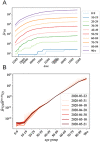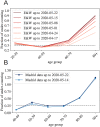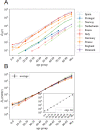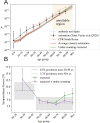A scaling approach to estimate the age-dependent COVID-19 infection fatality ratio from incomplete data
- PMID: 33596249
- PMCID: PMC7888669
- DOI: 10.1371/journal.pone.0246831
A scaling approach to estimate the age-dependent COVID-19 infection fatality ratio from incomplete data
Abstract
SARS-CoV-2 has disrupted the life of billions of people around the world since the first outbreak was officially declared in China at the beginning of 2020. Yet, important questions such as how deadly it is or its degree of spread within different countries remain unanswered. In this work, we exploit the 'universal' increase of the mortality rate with age observed in different countries since the beginning of their respective outbreaks, combined with the results of the antibody prevalence tests in the population of Spain, to unveil both unknowns. We test these results with an analogous antibody rate survey in the canton of Geneva, Switzerland, showing a good agreement. We also argue that the official number of deaths over 70 years old might be importantly underestimated in most of the countries, and we use the comparison between the official records with the number of deaths mentioning COVID-19 in the death certificates to quantify by how much. Using this information, we estimate the infection fatality ratio (IFR) for the different age segments and the fraction of the population infected in different countries assuming a uniform exposure to the virus in all age segments. We also give estimations for the non-uniform IFR using the sero-epidemiological results of Spain, showing a very similar increase of the fatality ratio with age. Only for Spain, we estimate the probability (if infected) of being identified as a case, being hospitalized or admitted in the intensive care units as function of age. In general, we observe a nearly exponential increase of the fatality ratio with age, which anticipates large differences in total IFR in countries with different demographic distributions, with numbers that range from 1.82% in Italy, to 0.62% in China or even 0.14% in middle Africa.
Conflict of interest statement
The authors have declared that no competing interests exist.
Figures






Similar articles
-
Assessing the age specificity of infection fatality rates for COVID-19: systematic review, meta-analysis, and public policy implications.Eur J Epidemiol. 2020 Dec;35(12):1123-1138. doi: 10.1007/s10654-020-00698-1. Epub 2020 Dec 8. Eur J Epidemiol. 2020. PMID: 33289900 Free PMC article.
-
Variation in the COVID-19 infection-fatality ratio by age, time, and geography during the pre-vaccine era: a systematic analysis.Lancet. 2022 Apr 16;399(10334):1469-1488. doi: 10.1016/S0140-6736(21)02867-1. Epub 2022 Feb 24. Lancet. 2022. PMID: 35219376 Free PMC article.
-
Impact of lockdown on Covid-19 case fatality rate and viral mutations spread in 7 countries in Europe and North America.J Transl Med. 2020 Sep 2;18(1):338. doi: 10.1186/s12967-020-02501-x. J Transl Med. 2020. PMID: 32878627 Free PMC article.
-
A systematic review and meta-analysis of published research data on COVID-19 infection fatality rates.Int J Infect Dis. 2020 Dec;101:138-148. doi: 10.1016/j.ijid.2020.09.1464. Epub 2020 Sep 29. Int J Infect Dis. 2020. PMID: 33007452 Free PMC article.
-
SARS-CoV-2 infection fatality rate after the first epidemic wave in Mexico.Int J Epidemiol. 2022 May 9;51(2):429-439. doi: 10.1093/ije/dyac015. Int J Epidemiol. 2022. PMID: 35157072 Free PMC article.
Cited by
-
Temporal trends in hospitalizations and 30-day mortality in older patients during the COVID pandemic from March 2020 to July 2021.PLoS One. 2023 Sep 14;18(9):e0291237. doi: 10.1371/journal.pone.0291237. eCollection 2023. PLoS One. 2023. PMID: 37708110 Free PMC article.
-
Analysis of the time course of COVID-19 cases and deaths from countries with extensive testing allows accurate early estimates of the age specific symptomatic CFR values.PLoS One. 2021 Aug 18;16(8):e0253843. doi: 10.1371/journal.pone.0253843. eCollection 2021. PLoS One. 2021. PMID: 34407073 Free PMC article.
-
Analysis of the COVID-19 pandemic: lessons towards a more effective response to public health emergencies.Global Health. 2022 Feb 4;18(1):10. doi: 10.1186/s12992-022-00805-9. Global Health. 2022. PMID: 35120537 Free PMC article.
-
Why case fatality ratios can be misleading: individual- and population-based mortality estimates and factors influencing them.Phys Biol. 2020 Sep 23;17(6):065003. doi: 10.1088/1478-3975/ab9e59. Phys Biol. 2020. PMID: 32554901 Free PMC article.
-
Assessing the age specificity of infection fatality rates for COVID-19: systematic review, meta-analysis, and public policy implications.Eur J Epidemiol. 2020 Dec;35(12):1123-1138. doi: 10.1007/s10654-020-00698-1. Epub 2020 Dec 8. Eur J Epidemiol. 2020. PMID: 33289900 Free PMC article.
References
-
- Worldometer. Coronavirus (COVID-19) Mortality Rate. https://wwwworldometersinfo/coronavirus/coronavirus-death-rate/. 2020;.
-
- Böttcher L, Xia M, Chou T. Why estimating population-based case fatality rates during epidemics may be misleading. arXiv preprint arXiv:200312032. 2020;.
Publication types
MeSH terms
LinkOut - more resources
Full Text Sources
Other Literature Sources
Medical
Miscellaneous

